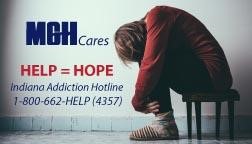Opioids and Heroin Addiction
The opioid and heroin epidemic is still very prevalent in Grant County. The opioid crisis plays out every day, an unending cycle of worry, hope and chaos for numerous families.
The Grant County Substance Abuse Task Force consists of 125 people and 30 agencies, all of whom were very busy in 2017 trying to make a difference on the substance abuse front. The first meeting was held in February at Marion Health, with representation from multiple disciplines across our community as well as a member from the office of U.S. Representative Susan Brooks.
 Positive changes have occurred in Grant County including a partnership
between Grant-Blackford Mental Health, Inc. (GBMH), the Grant County Jail
and Marion Health. This program initiates substance treatment and counseling with
inmates while they are incarcerated to prevent relapse when they are released
into the community. Marion Community Schools has taken on a student liaison
to attend juvenile court with students in hopes of identifying issues
that may be revolving around or eventually lead to substance abuse. James
Luttrell, Grant County Prosecutor, gave a detailed explanation of the
Family Recovery Court to address the common problem of multi-generational
substance abuse and the ripple effect that can engulf the entire family.
Also, Judge Dana Kenworthy was recently recognized by the state for her
team’s work in this area in creating a national model.
Positive changes have occurred in Grant County including a partnership
between Grant-Blackford Mental Health, Inc. (GBMH), the Grant County Jail
and Marion Health. This program initiates substance treatment and counseling with
inmates while they are incarcerated to prevent relapse when they are released
into the community. Marion Community Schools has taken on a student liaison
to attend juvenile court with students in hopes of identifying issues
that may be revolving around or eventually lead to substance abuse. James
Luttrell, Grant County Prosecutor, gave a detailed explanation of the
Family Recovery Court to address the common problem of multi-generational
substance abuse and the ripple effect that can engulf the entire family.
Also, Judge Dana Kenworthy was recently recognized by the state for her
team’s work in this area in creating a national model.
The Marion Health Emergency Department has continued the trend of minimizing controlled substances being prescribed and utilizing best practices in treating pain. There are two new resources for treatment emerging in our area. The Bowen Center, which has locations all over the state, has opened an outpatient facility in Grant County. Another group, entitled “Groups”, has opened an office in Grant County and will offer another alternative in medication-assisted treatment for residents.
GBMH continues to diligently serve as experts in mental health and addictions. They have launched a phone application that prompts clients in real time with recovery questions and coping skills. They also have a peer support specialist position that has been filled by a former drug court graduate to encourage clients during their recovery journey. The above-mentioned include just a few of the accomplishments. Each partner has made individual strides in tackling the opioid and heroin epidemic.
Several goals were identified for 2018 for our county. As we look ahead to the task at hand, it can seem daunting and overwhelming, but when looking back at the work that has been accomplished while locking arms and choosing to tackle the problem as a community, there is no obstacle that cannot be overcome.

